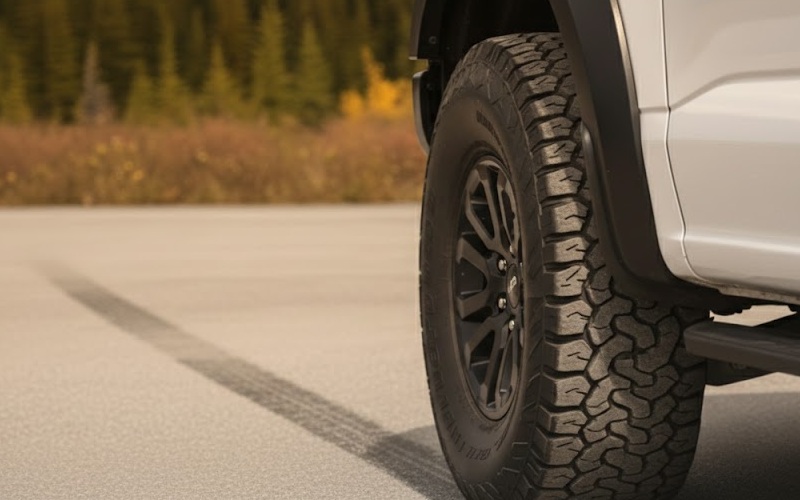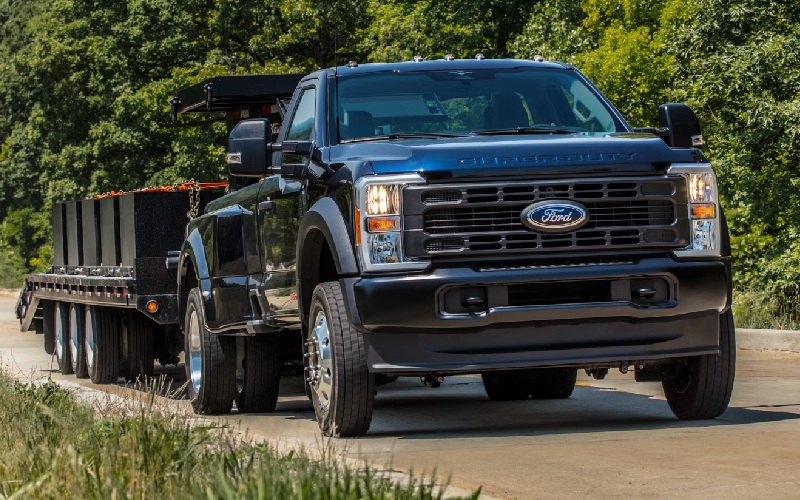Canada’s diverse summer landscape presents unique challenges for Ford truck owners. From scorching urban heat in Toronto and Montreal to rugged terrain in the Rockies and sudden summer storms across the Prairies, selecting the right tires becomes critical to safety, performance, and durability. This guide explores the optimal summer options for Ford trucks in the Canadian context, considering the specific demands of various regions and driving conditions.

Canadian Summer Conditions
Canadian summers vary dramatically by region, creating distinct tire requirements:
- Southern Ontario and Quebec: Hot, humid conditions with temperatures frequently exceeding 30°C, occasional heavy rainstorms, and primarily paved driving surfaces.
- Prairie Provinces: Extreme temperature fluctuations, from cool mornings to scorching afternoons, with gravel roads common in rural areas.
- British Columbia Lower Mainland: Moderate temperatures with frequent precipitation, even during summer months.
- Northern Regions: Shorter but intense summers with rapidly changing conditions and greater likelihood of encountering unpaved surfaces.
- Rocky Mountain Regions: Sharp temperature variations, rugged terrain, and significant elevation changes.
These diverse conditions mean Ford truck owners must carefully consider tire selection based on their primary driving environment, with particular attention to tread patterns, rubber compounds, and construction methods.
Ford Truck Models and Their Tire Requirements
The Ford truck lineup in Canada includes several models, each with specific requirements:
Ford F-150
As Canada’s bestselling pickup, the F-150 offers multiple trim levels with different specifications:
- Base XL/XLT trims: Typically equipped with P245/70R17 or P265/70R17
- Lariat/King Ranch: Often fitted with P275/65R18 or P275/55R20
- Raptor: Specialized with LT315/70R17 all-terrain
Ford Ranger
The midsize Ranger typically comes with:
- XL/XLT: P255/70R16 or P255/65R17
- Lariat/Tremor: P265/60R18 or P285/70R17 all-terrain
Ford Super Duty (F-250, F-350)
Heavy-duty trucks require robust specifications:
- Standard configurations: LT245/75R17 or LT275/65R18
- Premium trims: LT275/65R20 or larger
- Dual rear wheel models: LT245/75R17 on specific wheels
Understanding the specific requirements of your Ford truck is essential before selecting summer tires. The vehicle placard (typically found in the driver’s door jamb) indicates the manufacturer’s recommended size, load rating, and inflation pressure.
Critical Summer Tire Considerations for Canadian Driving
Temperature Resilience
Summer temperatures in Canadian cities can reach extremes, with Toronto, Ottawa, and Montreal regularly experiencing 30°C+ days. Quality summer opitons should feature:
- Heat-resistant rubber compounds that maintain grip and structural integrity in high temperatures
- Adequate heat dissipation channels to prevent overheating during highway driving
- UV-resistant materials to prevent premature aging from intense summer sunlight
Wet Performance
Summer thunderstorms are common across Canada, demanding tires with:
- Effective water evacuation channels (typically 7-8 mm deep for summers)
- Silica-enhanced compounds that maintain grip on wet surfaces
- Specialized siping patterns that resist hydroplaning at highway speeds
For context, a quality summer truck tire should be able to evacuate between 15-30 liters of water per second at 90 km/h.
Durability for Varied Surfaces
Even in summer, many Canadian truck owners regularly encounter varying surface conditions:
- Construction-grade asphalt on highways
- Chip-sealed provincial roads
- Gravel access roads to recreational areas
- Occasional off-road conditions at campsites or cottages
This diversity necessitates tires with adequate puncture resistance and sidewall strength, which is particularly important for Ford truck owners who use their vehicles for both work and pleasure.
Types of Summer Tires Suitable for Ford Trucks
Highway Terrain (H/T)
Ideal for F-150 and Ranger owners who primarily drive on paved roads, H/T tires offer:
- Continuous center ribs for stable highway performance and reduced road noise
- Typically deeper tread (8-10 mm) than passenger car tires for longer wear
- Load ratings appropriate for moderate hauling and towing
- Better fuel efficiency than more aggressive patterns
Examples well-suited to Ford trucks include options with symmetrical tread patterns designed for even wear and highway stability, with typical sizes ranging from 255/70R17 to 275/55R20 depending on the specific model and trim.
All-Terrain (A/T)
For Ford owners who split their time between highways and light off-road conditions, A/T tires provide versatility:
- More aggressive tread patterns with 12-14 mm depth
- Reinforced sidewalls with scuff protectors
- Staggered shoulder blocks for additional traction on loose surfaces
- Multi-pitch tread designs to reduce highway noise
Modern A/T tires have significantly improved their on-road manners while maintaining off-road capability, making them increasingly popular among F-150 and Ranger owners who frequent cottage country or enjoy outdoor activities.
Street/Sport Truck Tires
Owners of street-focused Ford trucks (particularly sport-trimmed F-150s) might consider performance-oriented truck rubber:
- Lower profile (typically 50-65 series) for improved handling
- Enhanced sidewall stiffness for better cornering stability
- Performance rubber compounds for improved grip on dry pavement
- Typically 255-305 mm section widths, depending on wheel size
These tires sacrifice some rough-road capability for improved on-road performance, making them suitable for urban and suburban driving in southern Canadian cities.
Specifications for Ford Trucks
Load Ratings
Ford trucks require tires with appropriate load ratings to safely handle their carrying capacity:
- F-150: Typically requires load range C (standard) to E (heavy-duty)
- Ranger: Usually requires load range C (standard duty)
- Super Duty: Requires minimum load range E
In metric terms, load ranges correspond approximately to:
- Load Range C: 1,580-1,800 kg per
- Load Range E: 2,300-3,080 kg per
Exceeding recommended load ratings compromises safety and longevity.
Speed Ratings
For summer driving in Canada, appropriate speed ratings include:
- R (170 km/h) – Sufficient for basic work trucks
- S (180 km/h) – Common on standard Ford trucks
- T (190 km/h) – Typical for all-terrain
- H (210 km/h) – Found on premium highway options
While Canadian speed limits typically max out at 110-120 km/h, higher speed ratings often indicate better construction quality and heat resistance.
Tread Wear Ratings
Tread wear ratings indicate relative longevity, with higher numbers suggesting longer life. For Ford trucks in Canadian summer conditions:
- 400-500: Typical for soft-compound performance
- 500-600: Common for all-terrain
- 600-800: Expected for highway-terrain
These ratings help estimate relative longevity, though actual wear depends on driving habits, load, and road conditions.
Regional Considerations for Canadian Ford Truck Owners
Urban Southern Canada
For Ford trucks in Toronto, Montreal, Windsor, and other southern urban centers:
- Priority: Heat resistance, wet performance, and ride comfort
- Recommended: Highway terrain tires with adequate wet grip
- Key specification: Temperature rating “A” for consistent performance in urban heat islands
British Columbia Lower Mainland
For Vancouver and surrounding areas:
- Priority: Excellent wet weather performance, versatility for weekend recreation
- Recommended: Highway terrain or mild all-terrain tires with superior wet braking
- Key specification: Circumferential grooves of at least 7 mm depth for water evacuation
Prairie Provinces
For Saskatchewan, Manitoba, and Alberta truck owners:
- Priority: Heat and gravel resistance, versatility for farm/ranch use
- Recommended: Durable all-terrain tires with cut-resistant compounds
- Key specification: Reinforced sidewalls and chip-resistant tread compounds
Cottage Country Considerations
For weekend warriors heading to Muskoka, Laurentians, or Rocky Mountain retreats:
- Priority: On-road comfort with occasional off-road capability
- Recommended: Crossover all-terrain tires with balanced performance
- Key specification: 3-ply sidewall construction for additional puncture protection
Tire Maintenance for Canadian Summer Conditions
Proper Inflation Pressure
Maintaining correct pressure is critical in fluctuating Canadian temperatures:
- Check pressure when tires are cold (driven less than 1.6 km)
- Adjust for ambient temperature changes (pressure typically increases by about 7 kPa for every 5.5°C increase)
- F-150 typically requires: 240-275 kPa (front), 255-310 kPa (rear)
- Ranger typically requires: 230-255 kPa (front), 230-275 kPa (rear)
- Adjust upward by 15-20 kPa when carrying heavy loads
Underinflation by just 20% can reduce rubber life by 15% while decreasing fuel efficiency.
Rotation Patterns
Regular rotation ensures even wear, particularly important for 4WD Ford trucks:
- Forward cross pattern for most 4×4 Ford trucks
- Rearward cross for F-150 with directional tires
- Side-to-side for staggered setups (uncommon on Ford trucks)
Recommended rotation interval: Every 8,000-10,000 km for typical Canadian driving.
Alignment Considerations
Canadian roads, particularly after winter, often suffer from potholes and surface damage that affect alignment:
- Check alignment after significant impact or when noticing uneven wear
- Proper camber settings prevent premature edge wear
- Toe settings particularly important for highway stability
Many Ford truck owners benefit from slightly adjusted alignment settings if they regularly carry heavy loads.
Specialized Applications for Ford Truck Owners
Towing Considerations
For summer cottage or boat towing:
- Look for “Max Load” designation
- Consider E-rated options even for half-ton F-150s when regularly towing near capacity
- Standard highway options sufficient for Ranger when towing within rated capacity
- Maintain inflation at upper recommended levels (typically 275-310 kPa)
Tires designed specifically for towing applications often feature stiffer sidewalls and heat-resistant compounds to handle the additional stress.
Work Site Requirements
For construction or resource industry applications:
- Consider LT-designated tires with puncture-resistant features
- Look for options with stone ejectors in tread design
- Prioritize sidewall protection over absolute on-road comfort
- Consider 10-ply rated tires for Super Duty trucks in demanding environments
The additional cost of commercial-grade tires often pays dividends in reduced downtime in professional applications.
Balancing Considerations for Optimal Performance
Fuel Efficiency vs. Capability
Ford truck owners often need to balance competing priorities:
- Lower-profile highway tires typically offer 5-7% better fuel efficiency than aggressive all-terrains
- Each additional 10 mm of width can reduce fuel economy by approximately 0.5-1%
- Larger diameter tires affect gearing and can either improve or worsen efficiency depending on driving conditions
For F-150 models with EcoBoost engines, wheel selection can influence real-world fuel consumption by up to 2 L/100 km in extreme cases.
Noise Considerations
Noise becomes significant on longer Canadian highway drives:
- Highway tires typically generate 68-72 dB at 100 km/h
- All-terrain tires typically produce 72-76 dB at the same speed
- Modern variable-pitch tread designs can reduce perceived noise by interfering with specific frequency ranges
Many premium options now include specific noise-reduction technologies that make a noticeable difference on the Trans-Canada Highway.
Summer Tires For Ford Trucks: Make the Optimal Choice
Selecting summer tires for Ford trucks in Canada requires balancing regional climate, typical use cases, and specific vehicle requirements. The optimal choice delivers confidence in various conditions while providing reasonable tread life and comfort appropriate to the vehicle’s use.
For most F-150 owners in urban and suburban environments, premium highway-terrain options deliver the best overall experience. At the same time, those who regularly venture to remote locations benefit from the versatility of all-terrain options. Ranger owners often prefer slightly more aggressive wheels given the vehicle’s adventure-oriented positioning, while Super Duty owners should prioritize load capacity and durability above all else.
Regardless of specific choice, quality summer options represent one of the most impactful investments in your Ford truck safety and capability in Canadian conditions, transforming how your vehicle handles the diverse demands of Canadian summer driving – from scorching city streets to remote lakeside getaways.






